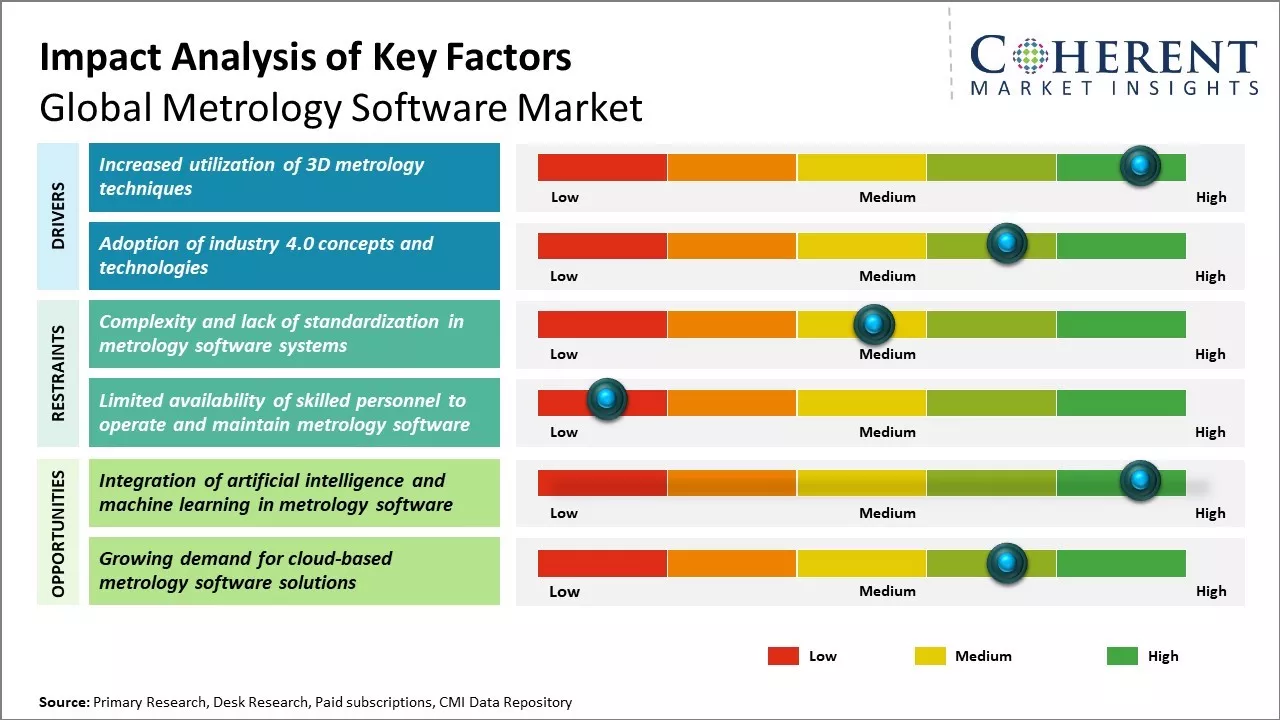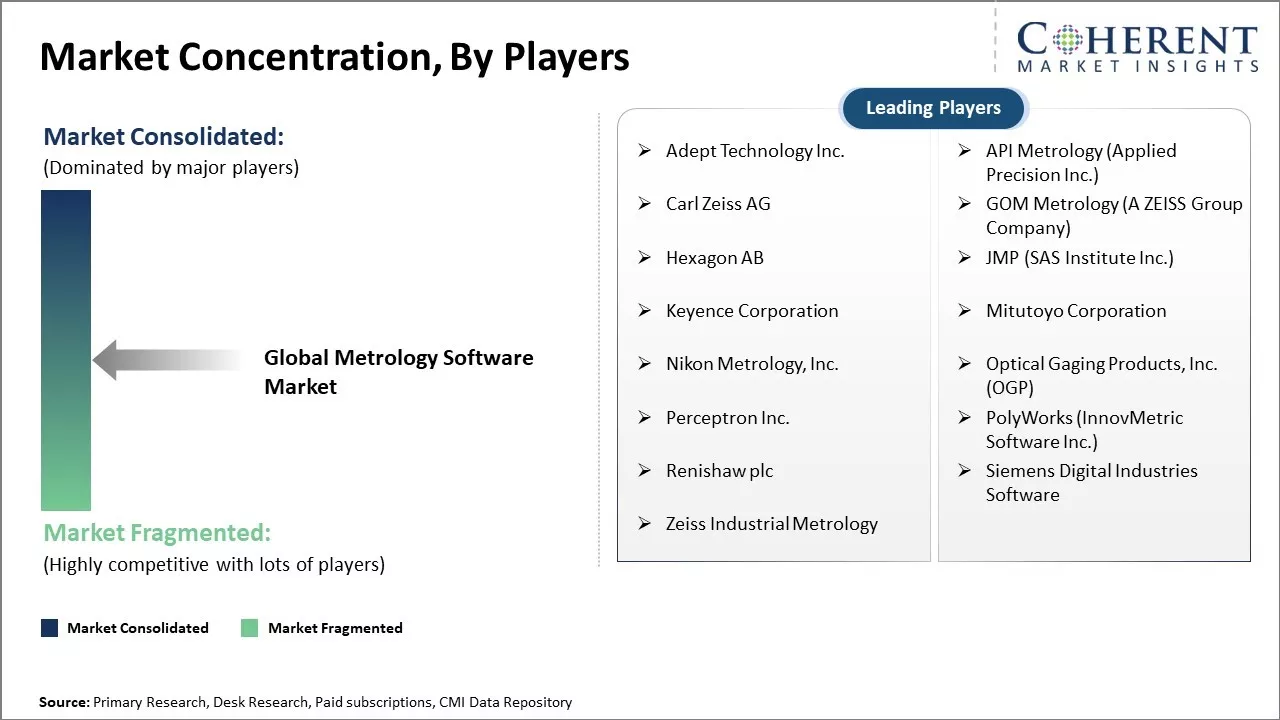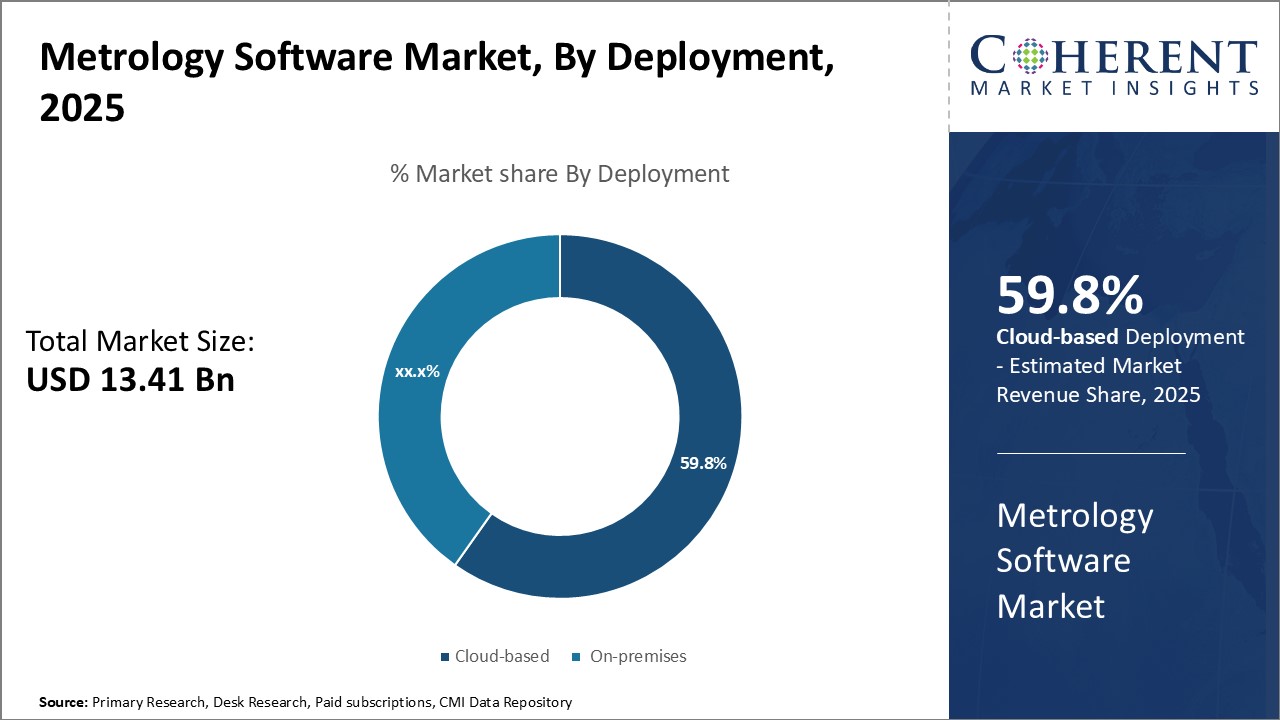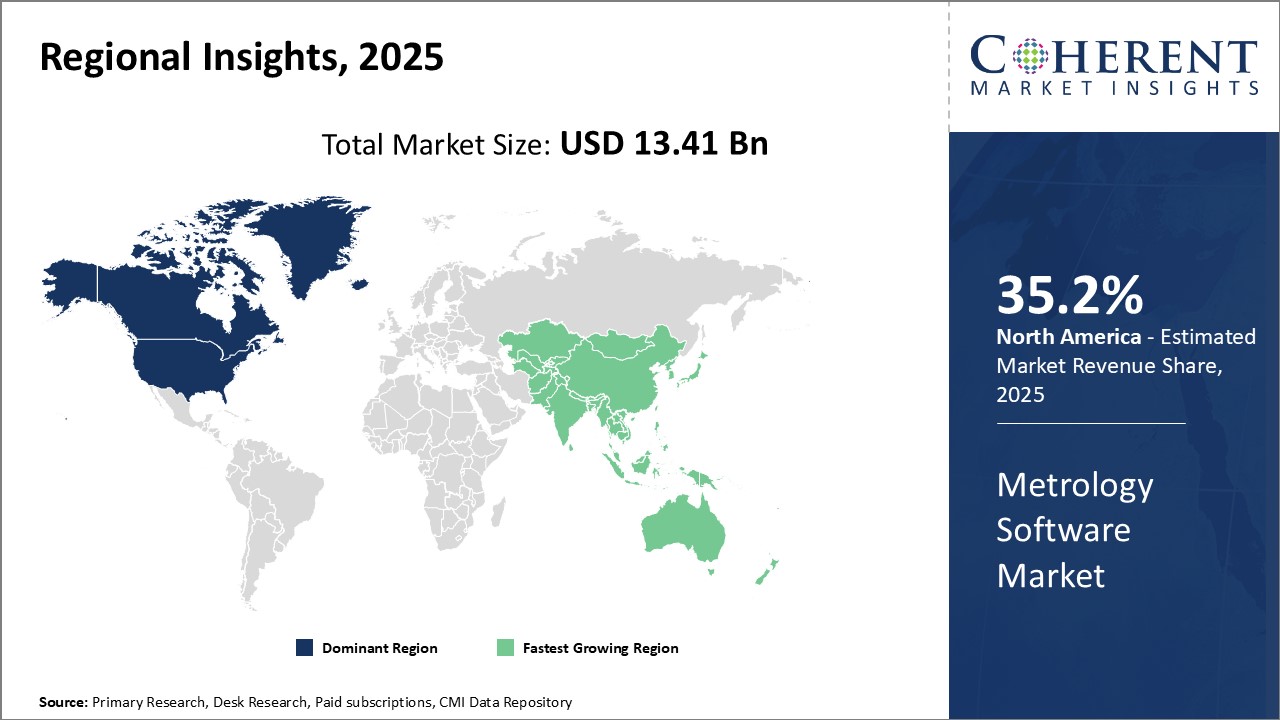The Global Metrology Software Market is estimated to be valued at US$ 12.46 Bn in 2024 and is expected to reach US$ 20.53 Bn by 2031, exhibiting a compound annual growth rate (CAGR) of 7.4% from 2024 to 2031.

To learn more about this report, request sample copy
The metrology software market is witnessing positive trends due to increased automation in manufacturing and the rise of industry 4.0. Metrology software allows for precise measurements to be taken and ensures quality control standards are met in production. As more factories digitize processes and integrate IIoT technologies, the need for automated metrology will continue growing. The demand from the automotive industry is a big driver of sales as autonomous vehicles require intricate systems that must function perfectly. Overall, metrology software helps improve efficiency, reduce costs, and assists manufacturers meet the stringent quality demands of customers - factors which are boosting the industry.
Increased utilization of 3D metrology techniques
The rapid proliferation of 3D metrology techniques across various industries has significantly propelled the demand for metrology software solutions. Manufacturers are increasingly leveraging 3D metrology including coordinate measuring machines, laser scanners, and optical digitizers to enable non-contact measurement of parts and components. 3D metrology allows detailed examination and dimensional inspection of complex geometries with minimal manual contact. This has helped improve quality control and reduce product development cycles significantly.
Metrology software plays a critical role in harnessing the full potential of 3D metrology hardware by providing advanced tools for scan data processing, dimensional measurement analysis, statistical process control, CAD comparison, reporting and more. Sophisticated software solutions with capabilities such as scan data registration, hole analysis, surface roughness analysis, geometrical dimensioning, and tolerancing ensure efficient integration of measurement data with downstream CAD/CAM workflows. They facilitate automated verification of as-manufactured parts against their original 3D CAD designs. This boosts reproducibility and traceability across the product lifecycle. The aerospace, automotive, medical, and other demanding manufacturing industries have especially benefited through accelerated validation of complex precision parts using 3D metrology methods supported by feature-rich metrology software.

Get actionable strategies to beat competition: Get instant access to report
Adoption of industry 4.0 concepts and technologies
The progressive application of advanced Industry 4.0 concepts focusing on interconnectivity, automation, machine learning, and data analytics across industrial operations is another key driver for the metrology software market growth. Manufacturers are increasingly leveraging IIoT-enabled metrology hardware, analytics solutions as well as cyber-physical systems to derive actionable insights from metrology data for enhancing quality, productivity, and decision making. Metrology software plays a vital role in empowering these Industry 4.0 initiatives by providing advanced analytics and reporting functions, centralized data management platforms as well as interfaces for real-time data transfer with MES/ Enterprise resource planning - ERP systems.
Feature-rich statistical process control modules in metrology software help manufacturers identify underlying production issues and deviations by monitoring process capability over time. This drives continuous improvements through data-driven adjustments to machining parameters, tooling configurations, and other manufacturing variables. Cloud-based metrology software platforms further support collaboration and data exchange between globally distributed design, manufacturing, and service teams.
Key Takeaways from Analyst:
Metrology software allows gathering precise dimensional measurement data through coordination with CMM machines, 3D scanners, and other metrology devices. This enables faster processing of inspection data and facilitates better decision making related to quality control and improvement.
The market will also benefit from the growing focus on Industry 4.0 technologies. More manufacturers are incorporating smart, connected technologies including metrology software into their production processes to gain productivity advantages from data-driven insights. The automotive industry in particular will accelerate demand as automakers seek to enhance assembly line quality control through robotic measurement systems integrated with metrology platforms. However, high upfront installation and maintenance costs of metrology software solutions may pose a challenge for small and mid-sized manufacturers. Market players must offer flexible pricing and rental models to expand in these customer segments.
The Asia Pacific region is expected to witness the fastest growth in the metrology software market owing to rising manufacturing activities and Quality 4.0 adoption among industrial facilities.
Market Challenges: Complexity and lack of standardization in metrology software systems
The complexity and lack of standardization in metrology software systems is significantly restraining the growth of the global metrology software market. Metrology software comes in various types to suit different metrology needs such as coordinate measuring machine (CMM) software, optical digitizers and scanners with programming suites, vision test measurement (VTM) software, and multisensory measurement software. However, each of these software types has their own proprietary file formats, programming languages, operating procedures, and technical requirements. Transitioning from one metrology software to another requires extensive rework and reprogramming to cope with the divergence in standards. Metrology software providers also keep changing and adding to their feature-sets through frequent product updates, which in turn demands continuous training and adaptation from users.
This high degree of heterogeneity imposes considerable switching costs on users and restricts them from efficiently leveraging different metrology systems as per their evolving measurement needs. For any industry, especially those in highly regulated fields like automotive and aerospace, aligning metrology protocols, and infrastructure across global facilities is crucial for harmonized quality control and seamless data integration. But the lack of common software standards compromises this interoperability and limits multi-site benchmarking of metrology performance. It discourages standardized procurement by large multinational manufacturers and hinders the proliferation of metrology into new application areas.
Market Opportunities: Integration of artificial intelligence and machine learning in metrology software
Integration of AI and machine learning in metrology software has the potential to significantly transform the global metrology software market. Metrology involves precise measurements and quality inspection which traditionally require skilled technicians and heavy instrumentation. By leveraging AI abilities like computer vision, deep learning, and predictive analytics, metrology software can autonomously perform inspection and measurement tasks with improved accuracy and speed. This reduces human error and makes inspection processes more efficient and cost-effective for manufacturers.

Discover high revenue pocket segments and roadmap to it: Get instant access to report
Insights By Deployment - Scalability and Lower Costs Drive Cloud Adoption
In terms of Deployment, the Cloud-based segment is estimated to hold 59.3% share of the market in 2024 owing to its scalability and lower costs compared to on-premises solutions. Cloud-based metrology software allows companies to optimize infrastructure spending as they only pay for what they use on a periodic basis. This offers flexibility to companies with fluctuating metrology needs across different projects and product development cycles. Businesses do not have to make large up-front investments in hardware to set up an on-site metrology software system. With cloud, they can easily scale resources up or down depending on current requirements. This helps reduce unnecessary spending during lean periods.
The cloud model also eliminates the costs associated with maintaining dedicated IT staff and hardware infrastructure for on-premises deployment. All software updates, security fixes, backups etc are managed by cloud providers, saving client companies from these additional expenditures. Remote access capability from any internet-connected device further enhances the appeal of cloud-based systems. Metrology engineers and quality professionals can access the software and inspection data from anywhere rather than being tied down to desktop computers within the company network. This has proved valuable especially during the pandemic with widespread shift to remote working models.
Data storage is virtually unlimited on the cloud at nominal monthly charges. This is crucial for industries generating massive inspection and measurement data through metrology tools. With on-premises systems, expanding storage as data grows can involve major hardware investment which is avoidable on the cloud. Overall total cost of ownership is significantly lower for cloud deployment compared to on-premises over the long term, making it the preferred choice for most companies.
By Deployment Services - Consultancy Services Driving Software Integration
In terms of Services, the Software Consulting segment is estimated to hold 39.4% share in 2024 as it helps clients integrate metrology applications with their existing workflows and IT environments. Effective integration with other systems such as ERP, MES, PLM, etc. is critical to derive optimal value from metrology investments. Consultants provide guidance on how to map inspection processes digitally as well as connect metrology data sources with downstream applications for reporting, analytics, etc.
They work with clients to understand current product development practices and quality management procedures. This helps identify areas where metrology tools can automate manual tasks, eliminate redundancy and bottlenecks. Consultants then advise the best applications and configuration suitable for the client’s specific needs. This ensures a seamless implementation with minimum disruptions to ongoing operations.
As metrology applications become more advanced with incorporation of AI/ML capabilities, the level of technical expertise required is elevated. Consultants assist with deployment of these emerging features and explain how they empower new use cases like predictive maintenance, root cause analysis, zero defect manufacturing and more. They help clients maximize returns from their software investments.
Consulting services are therefore in high demand especially during initial adoption to lay the right foundation and integration architecture. This drives its leading share in the services segment.
Insights By End-use Industry - Healthcare Adoption Motivated by Quality Control Needs
Additionally, in terms of End-use Industry, the Healthcare segment is estimated to hold 41.1% share of the market in 2024 as metrology assumes heightened importance in manufacturing medical devices and pharmaceuticals. Ultra-precise quality control is paramount in these sectors dealing with human lives. Even minor defects or non-conformities could have safety repercussions.
Healthcare products are subject to stringent regulatory approvals requiring thorough documentation of inspection and testing data. Automated metrology systems with integrated reporting aligned to regulatory guidelines help manufacturers streamline compliance processes. This reduces delays and saves enormous costs compared to traditional manual methods.
There is zero tolerance for errors in dosage uniformity, materials purity, dimensions etc. Advanced metrology solutions with 3D scanning, AI-based pass/fail assessment, etc. enable defect-free production essential for healthcare. Their adoption is continuously rising to meet regulatory requirements for quality and ensure patient wellbeing.
New medical technologies also drive complexity, requiring innovative metrology solutions. The industry is thus an early adopter and continues investing in the latest metrology innovations to maintain quality control at all stages from product development to final packaging. This substantiates healthcare’s leadership in metrology software consumption.

To learn more about this report, request sample copy
North America has established itself as the dominant region in the global metrology software market with an estimated 34.7% share in 2024. The presence of major metrology software vendors and metrology equipment manufacturers in countries like the U.S. and Canada has fueled market growth. Leading vendors in North America are constantly investing in innovative metrology software to enhance the capabilities of their metrology solutions. This has led to the early adoption of advanced metrology software compared to other regions.
The automotive industry has a large presence in North America and is one of the major end-users of metrology software. With automakers focusing on quality control and manufacturing efficiency, demand for metrology software is high. Additionally, the aerospace industry, another major market for metrology solutions, is well-developed in North America. This has further augmented demand over the years. The region also has a highly skilled workforce and a culture of embracing new technologies faster than others. These factors have contributed significantly to North America's position as the dominant regional market.
Asia Pacific has emerged as the fastest-growing region in the global metrology software market. Countries such as China, India, Japan, and South Korea are spearheading growth. The growth can be attributed to increasing manufacturing activities in Asia Pacific, with industries like automotive and electronics proliferating. There is also a rising focus on quality control and adopting Industry 4.0 practices. This has translated to higher demand for metrology software from both international as well as domestic vendors. Additionally, price-sensitive customers and low-cost manufacturing have encouraged vendors to focus on the Asia Pacific region and develop cost-effective solutions. Countries like China and India also offer a large talent pool, which major vendors are leveraging to strengthen their presence. The above factors are driving the rapid growth of the metrology software market in Asia Pacific.
Metrology Software Market Report Coverage
| Report Coverage | Details | ||
|---|---|---|---|
| Base Year: | 2023 | Market Size in 2023: | US$ 12.46 Bn |
| Historical Data for: | 2019 To 2023 | Forecast Period: | 2024 To 2031 |
| Forecast Period 2024 to 2031 CAGR: | 7.4% | 2031 Value Projection: | US$ 20.53 Bn |
| Geographies covered: |
|
||
| Segments covered: |
|
||
| Companies covered: |
Adept Technology Inc., API Metrology (Applied Precision Inc.), Carl Zeiss AG, GOM Metrology (A ZEISS Group Company), Hexagon AB, JMP (SAS Institute Inc.), Keyence Corporation, Mitutoyo Corporation, Nikon Metrology, Inc., Optical Gaging Products, Inc. (OGP), Perceptron Inc., PolyWorks (InnovMetric Software Inc.), Renishaw plc, Siemens Digital Industries Software, and Zeiss Industrial Metrology |
||
| Growth Drivers: |
|
||
| Restraints & Challenges: |
|
||
Uncover Macros and Micros Vetted on 75+ Parameters: Get Instant Access to Report
*Definition: The Global Metrology Software Market involves the use of specialized software to enable effective quality control and inspection activities across manufacturing industries worldwide. This market consists of software solutions that help perform measurement and inspection of physical components and products using 3D scanning, photography and computer-aided design integration. Metrology software automates inspection workflows, collects measurement data for statistical process control and facilitates compliance with international quality standards. They help improve manufacturing accuracy and productivity for industries such as automotive, aerospace, defense, and heavy machinery.
Share
About Author
Suraj Bhanudas Jagtap
Suraj Bhanudas Jagtap is a seasoned Senior Management Consultant with over 7 years of experience. He has served Fortune 500 companies and startups, helping clients with cross broader expansion and market entry access strategies. He has played significant role in offering strategic viewpoints and actionable insights for various client’s projects including demand analysis, and competitive analysis, identifying right channel partner among others.
Missing comfort of reading report in your local language? Find your preferred language :
Transform your Strategy with Exclusive Trending Reports :
Frequently Asked Questions
Joining thousands of companies around the world committed to making the Excellent Business Solutions.
View All Our Clients